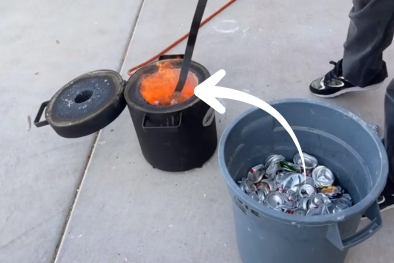
An aluminum can is a cylinder made of thin metal sheet fastened by stamping. The bottom has a concave shape for strength, and the top includes the familiar “opener.” The metal is mostly homogeneous, with a tiny amount of tin and a thin ocher paint layer used for printing logos. Don’t worry about the paint — its impurities will burn away during melting.
To get started, you’ll need:
After that, your method of melting depends on whether you use a hearth or a muffle furnace.
This is the most primitive and accessible method.
After about an hour, the aluminum will begin to melt and burn off the paint. Pour the molten metal into gypsum molds for shaping.
A muffle furnace is a sealed metal case lined with heat-resistant materials such as ceramics or asbestos. Inside, a crucible (melting cavity) holds the cans while a gas burner flame heats them from below. Once loaded to capacity, the furnace can melt the cans in about 30 minutes. Many muffle furnaces have a faucet for safely draining the molten aluminum into molds.
There are older methods like using a fire pit or smelting pit in the ground, but these are largely outdated and unsafe. Modern approaches like the hearth or muffle furnace are more efficient and reliable.
Working with molten metal involves high temperatures and serious risk. Follow these safety tips carefully:
Each aluminum can contains 10–18 grams of metal, depending on its size. To collect a worthwhile quantity for recycling, you’ll need a large bag full. However, melting cans to make figurines or small cast items is often a more creative and rewarding way to reuse them.
Working with metal is a valuable and engaging skill — and aluminum smelting is a great place to start. It’s interesting, educational, and can even provide a small source of profit while promoting recycling and sustainability.
© 2022 Akshar Products, All Rights Reserved. Developed & Managed By Connect To India Pvt. Ltd. Privacy Policy | Term & Condition